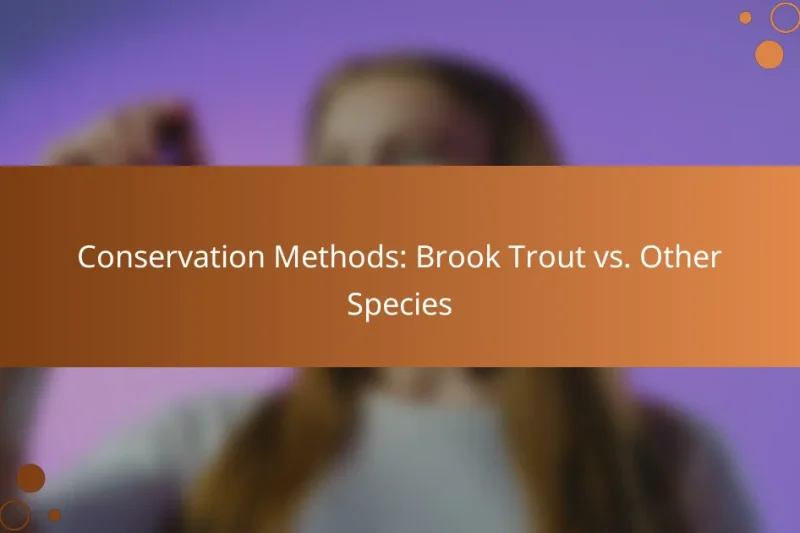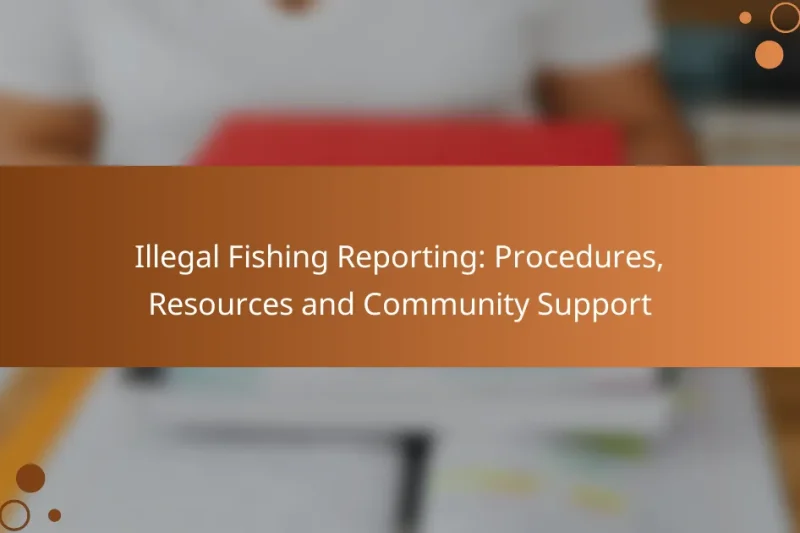Climate change is reshaping population dynamics by affecting migration patterns, displacing communities, and altering demographic trends. … Climate Change Effects: Population Trends, Habitat Loss and Adaptation StrategiesRead more
Brook Trout Conservation and Regulations
Brook Trout conservation is essential for maintaining healthy ecosystems and sustainable fish populations. It relies on habitat protection, community involvement, and ongoing research to ensure the species thrives. Fishing regulations, set by federal, state, and local authorities, play a crucial role in managing Brook Trout populations through licensing, seasonal restrictions, and size limits. Anglers can contribute to these efforts by practicing responsible fishing techniques and participating in local conservation initiatives.
State Regulations: Fishing Limits, Licensing Requirements and Seasonal Rules
Understanding state regulations on fishing is crucial for responsible anglers. These regulations typically cover fishing limits, … State Regulations: Fishing Limits, Licensing Requirements and Seasonal RulesRead more
Conservation Methods: Brook Trout vs. Other Species
Conservation methods for Brook Trout are tailored to address their specific habitat and ecological needs, employing … Conservation Methods: Brook Trout vs. Other SpeciesRead more
Brook Trout Conservation: Local Initiatives, Volunteer Opportunities and Community Engagement
Brook Trout conservation is vital for maintaining healthy aquatic ecosystems and enhancing local biodiversity. Community engagement … Brook Trout Conservation: Local Initiatives, Volunteer Opportunities and Community EngagementRead more
Local Organizations: Roles, Partnerships and Conservation Programs
Local organizations play a vital role in conservation by bridging the gap between communities and environmental … Local Organizations: Roles, Partnerships and Conservation ProgramsRead more
Illegal Fishing Reporting: Procedures, Resources and Community Support
Illegal fishing poses a significant threat to marine ecosystems and local economies, making it essential for … Illegal Fishing Reporting: Procedures, Resources and Community SupportRead more
Sustainable Fishing: Techniques, Gear Choices and Environmental Impact
Sustainable fishing practices are essential for preserving marine ecosystems and ensuring the long-term health of fish … Sustainable Fishing: Techniques, Gear Choices and Environmental ImpactRead more
What are the best practices for Brook Trout conservation?
Effective Brook Trout conservation involves habitat protection, community involvement, and ongoing research. These practices ensure sustainable populations and healthy ecosystems, which are vital for the species’ survival.
Habitat restoration techniques
Habitat restoration is crucial for maintaining Brook Trout populations. Techniques include removing barriers to migration, restoring stream banks, and improving water quality through riparian buffer zones. These actions help create a more suitable environment for spawning and growth.
Implementing natural materials, such as logs and boulders, can enhance stream complexity, providing shelter and feeding areas for trout. Regular assessments of habitat conditions can guide restoration efforts effectively.
Community engagement programs
Community engagement programs play a vital role in Brook Trout conservation. These initiatives can include educational workshops, volunteer clean-up events, and citizen science projects that involve local residents in monitoring trout populations and habitats.
By fostering a sense of ownership and responsibility, communities are more likely to support conservation efforts. Collaboration with local organizations can amplify the impact of these programs and ensure broader participation.
Monitoring and research initiatives
Monitoring and research initiatives are essential for understanding Brook Trout populations and their habitats. Regular data collection on fish populations, water quality, and habitat conditions helps identify trends and inform management decisions.
Partnerships with universities and research institutions can enhance these efforts, providing access to expertise and resources. Utilizing technology, such as telemetry and environmental DNA sampling, can improve the accuracy and efficiency of monitoring programs.
What regulations govern Brook Trout fishing in the United States?
Brook Trout fishing in the United States is regulated by a combination of federal, state, and local laws. These regulations cover various aspects including fishing licenses, seasonal restrictions, and size and bag limits to ensure sustainable populations of Brook Trout.
State-specific fishing licenses
Each state requires anglers to obtain a fishing license to legally fish for Brook Trout. The cost and type of license can vary significantly by state, with some offering annual, daily, or even multi-day options. It is essential to check your state’s wildlife agency for specific licensing requirements and fees.
Many states also offer discounted licenses for seniors, veterans, and youth. Additionally, some regions may have special permits for fishing in designated waters, which can include additional fees.
Seasonal fishing restrictions
Seasonal restrictions for Brook Trout fishing vary by state and are designed to protect fish populations during spawning periods. Generally, many states open their Brook Trout fishing seasons in late spring and close them in early fall, but specific dates can differ.
Some areas may have catch-and-release only periods or designated closed seasons to allow for recovery of fish populations. Always verify the specific seasonal regulations for the water bodies you plan to fish in.
Size and bag limits
Size and bag limits are crucial for maintaining healthy Brook Trout populations. Most states impose a minimum size limit, often around 8 to 12 inches, and a maximum bag limit, which can range from 2 to 10 fish per day depending on the location.
Some regions may have special regulations for trophy waters or catch-and-release areas, where anglers are encouraged to return larger fish to the water. Always consult local regulations to ensure compliance with size and bag limits before fishing.
How can anglers contribute to Brook Trout conservation?
Anglers can play a vital role in Brook Trout conservation by adopting practices that protect their populations and habitats. Simple actions like catch and release, reporting illegal activities, and engaging with local conservation efforts can significantly impact the sustainability of this species.
Participating in catch and release
Catch and release is a conservation practice where anglers return caught fish to the water, minimizing harm to the fish population. To do this effectively, use barbless hooks, handle fish gently, and minimize air exposure to reduce stress and injury.
Consider using a landing net to avoid damaging the fish’s skin and scales. If you plan to keep some fish, be aware of local regulations regarding size and bag limits to ensure you are not overharvesting.
Reporting illegal fishing activities
Reporting illegal fishing activities helps protect Brook Trout and their habitats from poaching and overfishing. If you witness suspicious behavior, such as fishing without a license or exceeding catch limits, contact local wildlife authorities or conservation organizations.
Many regions have hotlines or online platforms for reporting violations anonymously. Being vigilant and proactive can help maintain healthy fish populations and ecosystems.
Joining local conservation groups
Joining local conservation groups allows anglers to support initiatives aimed at preserving Brook Trout habitats and promoting sustainable fishing practices. These organizations often organize clean-up events, habitat restoration projects, and educational workshops.
Participating in these activities not only helps the environment but also connects you with like-minded individuals who share a passion for fishing and conservation. Look for groups in your area that focus on freshwater ecosystems and trout conservation specifically.
What are the threats to Brook Trout populations?
Brook Trout populations face several significant threats that jeopardize their survival. Key factors include climate change, pollution and habitat degradation, and competition from invasive species.
Climate change impacts
Climate change poses a serious threat to Brook Trout by altering water temperatures and flow patterns in their habitats. Warmer water can reduce oxygen levels, making it difficult for these fish to thrive, especially in summer months.
Additionally, changing precipitation patterns can lead to more frequent droughts or flooding, both of which can disrupt spawning and reduce habitat availability. Protecting cold-water streams is essential for maintaining healthy Brook Trout populations.
Pollution and habitat degradation
Pollution from agricultural runoff, industrial waste, and urban development significantly impacts Brook Trout habitats. Contaminants can lead to poor water quality, which affects the fish’s health and reproductive success.
Habitat degradation, such as the destruction of stream banks and the removal of natural vegetation, further exacerbates these issues. Conservation efforts should focus on reducing pollution sources and restoring natural habitats to support Brook Trout populations.
Invasive species competition
Invasive species, such as the Brown Trout and various non-native fish, compete with Brook Trout for food and habitat. These invaders can outcompete native species for resources, leading to declines in Brook Trout numbers.
Management strategies should include monitoring invasive species and implementing control measures to protect native Brook Trout populations. Maintaining biodiversity in aquatic ecosystems is crucial for the long-term survival of these fish.
What are the success stories in Brook Trout conservation?
Brook Trout conservation has seen numerous success stories, highlighting effective strategies and community involvement. These initiatives have led to improved habitats and increased populations in various regions.
Successful habitat restoration projects
Habitat restoration projects have played a crucial role in reviving Brook Trout populations. Efforts often include removing barriers to migration, restoring stream banks, and improving water quality. For instance, projects in the Appalachian region have focused on reforesting riparian zones to enhance shade and reduce water temperature.
In many cases, these projects are funded through grants and partnerships with local organizations. Engaging volunteers for tree planting or stream clean-ups can significantly lower costs while fostering community involvement.
Community-led conservation efforts
Community-led initiatives have proven effective in promoting Brook Trout conservation. Local fishing clubs and environmental groups often organize educational programs to raise awareness about sustainable fishing practices and habitat protection. These efforts empower residents to take ownership of their local waterways.
Successful examples include “Adopt-a-Stream” programs, where community members regularly monitor water quality and report changes. This grassroots involvement not only helps in conservation but also strengthens community ties and fosters a culture of stewardship.






